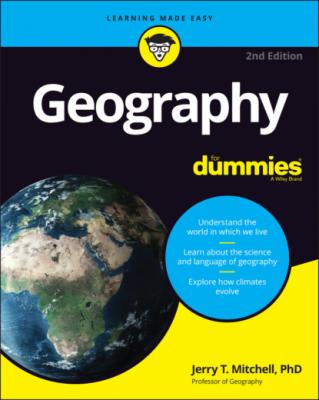ТОП просматриваемых книг сайта:
Geography For Dummies. Jerry T. Mitchell
Читать онлайн.Название Geography For Dummies
Год выпуска 0
isbn 9781119867142
Автор произведения Jerry T. Mitchell
Жанр География
Издательство John Wiley & Sons Limited
Why is Jakarta the capital of Indonesia?
An unpleasant setting: Jakarta is densely populated, has overburdened infrastructure, is sinking due to over withdrawal of groundwater, and floods frequently. A new location would allow growth and it would be generally free from environmental hazards such as volcanoes and earthquakes.
In the middle of it all: Jakarta is on the western edge of the country. East Kalimantan is in the middle. Having the capital in the center of the country is important because Indonesia is flung across thousands of miles. A central location does more to integrate the citizenry and a central location also maximizes access to the seat of power.
Getting to the Essentials
To get you accustomed to thinking geographically, this volume makes use of unifying concepts that will help you to understand the breadth and structure of the discipline. But what are these unifying concepts? Yogi Berra once supposedly ordered a pizza pie and was asked if he wanted it cut into four slices or eight. He opted for four and explained, “I don’t think I can eat eight.” Whether or not the story is true, a pizza pie is a pizza pie, no matter how you slice it up. The same is true of geography. In a manner of speaking, it’s a very big pizza pie. Over the years, geographers have devised different ways to cut it up in order to help people like you grasp its breadth and content. If you are a school teacher, you may have heard of the Five Themes of Geography or maybe even the Four Traditions. As I said, there have been many attempts to do this!
The “geography pizza slices” I’m going to introduce you to are The Six Essential Elements. They were developed by several professional geography organizations as part of the (United States) National Geography Standards, which describe in detail “what a geographically informed person knows and understands.” The National Geography Standards were written with the advice and input of professionals who specialize in diverse aspects of geography and, accordingly, represent a broad consensus of its scope and structure. Specifically, therefore, I have chosen The Six Essential Elements, which are:
The world in spatial terms
Places and regions
Physical systems
Human systems
Environment and society
Uses of geography
These may sound somewhat imposing, but rest assured, they refer to simple concepts that you encounter in your everyday life. Indeed, you are already familiar with each of them, though perhaps not by their formal titles. I can prove it to you.
Where things are in the world: The world in spatial terms
You probably have a preferred grocery store, clothing store, and restaurant, plus a map in your head that tells you where they are and how to get to them. What’s more, you could probably conjure up a route to visit all three in a single excursion and draw me a sketch map of the itinerary. If so, then you are already familiar with the world in spatial terms.
Knowing how to use and read maps and atlases, whether paper or digital, and identify how they can lie to you (yes, you read that correctly).
Acquiring a general understanding of the tools and techniques that geographers use to accurately locate things.
Being able to indicate the location of something using the system of latitude and longitude, or plain language.
Seeing relationships that explain the locations of things.
Recalling from memory the location of things on Earth’s surface.
These are basic skills to build on. On top of that, you’ll never have to worry if somebody tells you to “Get lost!”
Chapter 2, which shows you how to think like a geographer, is very much about understanding the world in spatial terms. Chapters 3, 4, and 5 are devoted to location and maps, and, therefore, focus rather directly on this element. In addition, several other chapters will contain at least one map. Thus, you will encounter the world in spatial terms again and again throughout this book.
What locations are like: Places and regions
What’ll it be for your next vacation? The mountains? The shore? Chances are you have mulled over questions like these that concern different areas with different characteristics. If so, then you are already familiar with places and regions.
Place: What a location looks like
Place responds to another important geographical question: “What is it like?” Place refers to the human and physical features that characterize different parts of Earth and that are responsible for making one location look different from the next. The terminology may puzzle you, because in everyday speech, people commonly use location and place interchangeably. In geography, however, these two terms have separate and distinct meanings. Location tells you where. Place tells you what it’s like. In other words, places are locations to which humans have assigned meaning.
Take, for example, the proliferation of streets in the United States named after Martin Luther King, Jr. Are they locations? Sure, they are. They have specific addresses along them and they occupy space in hundreds of cities. But I think that we can also agree that they are imbued with much meaning and create unique places. Further, where they are located also says a lot about the people, history, politics, and so on in the neighborhoods where we find them.
Region: A bunch of locations with something in common
A region is an area of Earth, large or small,

